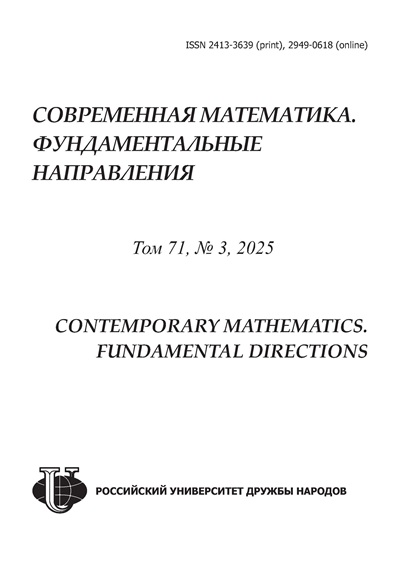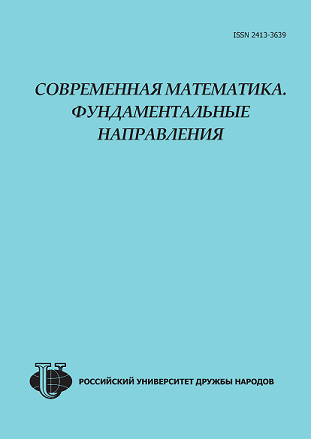Contemporary Mathematics. Fundamental Directions
Editor-in-Chief: Alexander L. Skubachevskii, Professor, Doctor of Physical and Mathematical Sciences, Peoples’ Friendship University of Russia named after Patrice Lumumba (RUDN University), Moscow, Russian Federation
ISSN: 2413-3639 (print), 2949-0618 (online).
Founded in 2003 г. Publication frequency: quarterly. Peer-Review: blind
Open Access:  . APC: no article processing charge.
. APC: no article processing charge.
Indexation: White List, elibrary.ru, mathnet.ru, journalrank.rcsi.science, Google Scholar, Lens, Research4Life
Publication language: Russian, English
Publisher: Peoples’ Friendship University of Russia named after Patrice Lumumba (RUDN University)
The journal "Contemporary Mathematics. Fundamental Directions" is published both in English and Russian.
The journal is devoted to the actual topics of contemporary mathematics.
The journal is focused on publication of surveys as well as articles containing novel results.
The English version is published by "Springer Science+Business Media, Inc." (USA) in the series "Journal of Mathematical Sciences." ISSN: 1072-3374 (print version) ISSN: 1573-8795 (electronic version)
Current Issue
Vol 71, No 3 (2025): Proceedings of the Crimean Autumn Mathematical School-Symposium
- Year: 2025
- Articles: 10
- URL: https://journals.rudn.ru/CMFD/issue/view/1946
- DOI: https://doi.org/10.22363/2413-3639-2025-71-3
Full Issue
Articles
On one method for solving the initial-boundary value problem for the Gardner equation
Abstract
In this paper, the efficient solution is considered for an initial-boundary value problem for the Gardner equation: a spatially one-dimensional nonlinear evolution equation describing a broad class of dispersive autowave processes. A numerical-analytical method is proposed based on a combination of explicit and implicit time discretization schemes for various terms of the differential operator. A new efficient algorithm is developed to solve a sequence of auxiliary linear problems, relying on analytical representations using an explicit form of the fundamental system of solutions. An example of a numerical solution of the initial-boundary value problem for the Gardner equation is considered, and the result is compared with a known exact solution of the solitary traveling wave type.
 353-369
353-369


Modeling of evolutionary strategies of interacting populations in a heterogeneous habitat
Abstract
Using a predator-prey model in a heterogeneous environment, we have created a mathematical model that describes the interaction between populations with different evolutionary strategies. The model is based on partial differential equations and allows for the consideration of multifactor taxis. We propose modified functions of local predator-prey interactions, which provide a variety of evolutionary strategies for the system. Key parameters responsible for the formation of ideal free distribution strategies have been investigated, and conditions for the parameters of diffusion and migration have been given under which ideal free distribution-like strategies can be implemented. Results from computational experiments demonstrating stationary and oscillating modes have been presented.
 370-384
370-384


Modeling of the study of viscoelastic deformation of elastic bodies
Abstract
This article proposes a numerical-analytical method for solving linear viscoelasticity problems of an anisotropic solid without the need for explicit analytical representations of creep and relaxation kernels. The approximate solution of integral equations is based on the direct use of experimental data, previously smoothed and filled with a finer mesh. Thus, solving boundary-value problems of viscoelasticity is reduced to solving elasticity problems at an arbitrary point in time.
 385-394
385-394


Existence and uniqueness of the solution of the initialboundary value problem for one-dimensional equations of the dynamics of a compressible viscous mixture
Abstract
In this paper, an initial-boundary value problem is studied for one-dimensional equations of the dynamics of a compressible viscous mixture. A theorem is proved for the existence and uniqueness of a solution to the initial-boundary value problem without any restrictions on the structure of the viscosity matrix other than the standard physical requirements of symmetry and positive definiteness.
 395-416
395-416


Lefschetz formula for nonlocal elliptic problems associated with fibration
Abstract
 417-442
417-442


Continuous generation population model with discontinuous life cycle characteristics
Abstract
Traditionally, continuous models of mathematical biology are focused on the dynamics of interacting populations as stationary homogeneous entities. The state of the populations in the equations is governed by factors common to all individuals \( \forall t,N(t) \): reproductive efficiency, mortality, living space limitations, or resource limitations. Many species exist with nonoverlapping generation sequences, replacing each other under different seasonal conditions. The number of annual generations is an important characteristic of the ecology of a species when occupying a new range. The length of the life cycle and the index of reproductive activity r in adjacent generations of insects in a range vary due to the need for wintering. Fluctuations in these values affect rapid population outbreaks. It is shown that the use of discrete models \( x_{n+1}=\psi(x_n;r)\varphi(x_{n-i})-\Xi \) is unrealistic for fundamental reasons. The appearance of cycles \( p\neq2^i \) in the order of Sharkovsky's theorem is excessive for the analysis of populations and the forecast of mass reproductions of insects. The article proposes a method for organizing models of the conjugate development of a succession of generations in a system of discontinuous differential equations as a sequence of boundary-value problems. The model is event-based redefined to obtain a solution on time intervals corresponding to the conditions of the season. The model taking into account competition and delayed regulation is relevant for the analysis of a sequence of peaks in pest activity, which are characterized by individual extremely numerous generations.
 443-451
443-451


Equiconvergence of expansions in root functions of a differential operator and in a trigonometric Fourier series
Abstract
We consider a non-self-adjoint ordinary differential operator defined on a finite interval by an \( n \)th-order linear differential expression with a nonzero coefficient of the \( (n-1) \)th derivative and two-point Birkhoff regular boundary conditions. We study the uniform equiconvergence of expansions of a given function in a biorthogonal series in eigenfunctions and associated functions (or, briefly, root functions) of this operator and in an ordinary trigonometric Fourier series, as well as an estimate of the difference of the corresponding partial sums (or, briefly, the rate of equiconvergence) under the most general conditions on the expanded function and the coefficient of the \( (n-1) \)th derivative. We obtain estimates for the difference of the expansions in terms of general (integral) moduli of continuity of the expanded function and the coefficient of the \( (n-1) \)th derivative uniform inside the fundamental interval. From these estimates, corresponding estimates are derived in the case where moduli of continuity are bounded from above by slowly varying functions and, in particular, by logarithmic functions. Based on this, sufficient conditions for equiconvergence in the indicated cases are formulated. These results are obtained using the author's previously obtained estimate for the difference between the partial sums of expansions of a given function in a biorthogonal series in eigenfunctions and associated functions of the differential operator under consideration and in a modified trigonometric Fourier series, as well as analogues of the Steinhaus theorem. The modification of the trigonometric Fourier series consisted in applying a very specific bounded operator to the ordinary trigonometric Fourier series expressed through the coefficient of the \( (n-1) \)th derivative and its inverse operator to the expanded function.
 452-477
452-477


The second four-electron singlet in the Hubbard impurity model
Abstract
 478-507
478-507


Oscillations of a viscous fluid with an inertial free surface
Abstract
 508-523
508-523


Spectral decomposition of self-adjoint operators in Pontryagin and Krein spaces
Abstract
We consider a self-adjoint operator acting in a Krein space and possessing an invariant subspace that is maximal nonnegative and decomposes into a direct sum of a uniformly positive (i.e., equivalent to a Hilbert space with respect to the inner pseudoscalar product) and a finite-dimensional neutral subspace. We prove the existence of a difference expression that transforms the moment sequence generated by this operator into a sequence representable as the difference of positive moment sequences. In the case of a cyclic operator, this result is applied to construct a function space in which the operator under study is modeled as the operator of multiplication by an independent variable.
 524-546
524-546












